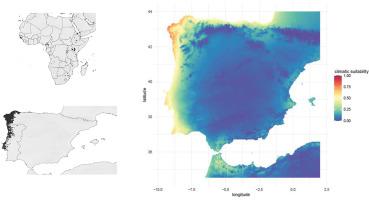Crop Protection ( IF 2.5 ) Pub Date : 2023-03-07 , DOI: 10.1016/j.cropro.2023.106228 Martin Godefroid

|
The African citrus psyllid, Trioza erytreae (Hemiptera: Triozidae), is a vector of citrus greening (Huanglonbing - HLB), a bacterial citrus disease caused by Candidatus liberibacter spp. Native to Africa, T. erytreae was detected in the Canary Islands and Madeira in the early 2000s and then in northwestern Spain in 2014. Since then, T. erytreae has become established along the Atlantic coastal areas of the Iberian Peninsula. Therefore, an accurate assessment of the potential long-term establishment of T. erytreae in major citrus-growing regions of Europe and the world is urgently needed to design adapted control strategies. I calibrated correlative species distribution models to understand the bioclimatic characteristics that determine the distribution of T. erytreae, and to assess the climatic suitability of the world's major citrus-growing regions for the psyllid under current and future climate conditions. I calibrated the models using only distribution data from Africa (its native range), the Canary Islands, and Madeira, and evaluated them using available data from the invaded area in continental Europe. This approach aims to avoid spurious good measures of model accuracy arising from spatial autocorrelation between the calibration and evaluation datasets. The models identify mild summer and winter temperatures and high levels of precipitation as optimal conditions for long-term psyllid establishment, consistent with its physiology. In Europe, models predict only the Atlantic coastal regions of the Iberian Peninsula as highly climatically suitable, a spatial pattern that corresponds exactly to the area currently invaded by the psyllid. Models predict that most of the important citrus-growing areas in the world are, and will remain in the future, poorly adapted to T. erytreae except in case of future physiological adjustments. These results are crucial for the design of appropriate pest management strategies and are timely for Europe where the African citrus psyllid has recently been detected.
中文翻译:

物种分布模型预测木虱 Trioza erytreae 的气候适宜性,柑橘绿化病的载体
非洲柑橘木虱Trioza erytreae(半翅目:Triozidae)是柑橘黄龙病(Huanglonbing - HLB)的传播媒介,是一种由Candidatus liberibacter spp. 引起的细菌性柑橘病害。T. erytreae原产于非洲,于 2000 年代初在加那利群岛和马德拉岛被发现,然后在 2014 年在西班牙西北部被发现。从那时起,T. erytreae已经在伊比利亚半岛的大西洋沿岸地区建立起来。因此,准确评估T. erytreae的潜在长期定殖欧洲和世界主要柑橘种植区迫切需要设计适应性控制策略。我校准了相关的物种分布模型,以了解决定T. erytreae分布的生物气候特征,并评估世界主要柑橘种植区在当前和未来气候条件下对木虱的气候适宜性。我仅使用来自非洲(其原产地)、加那利群岛和马德拉的分布数据校准模型,并使用来自欧洲大陆被入侵地区的可用数据对其进行评估。这种方法旨在避免由校准和评估数据集之间的空间自相关引起的模型精度的虚假良好测量。这些模型确定温和的夏季和冬季温度以及大量降水是木虱长期建立的最佳条件,与其生理学一致。在欧洲,模型预测只有伊比利亚半岛的大西洋沿岸地区气候适宜,与木虱当前侵入的区域完全对应的空间模式。模型预测,世界上大多数重要的柑橘种植区现在并且将来仍将不适应T. erytreae除非在未来的生理调整的情况下。这些结果对于设计适当的害虫管理策略至关重要,并且对于最近发现非洲柑橘木虱的欧洲来说是及时的。











































 京公网安备 11010802027423号
京公网安备 11010802027423号